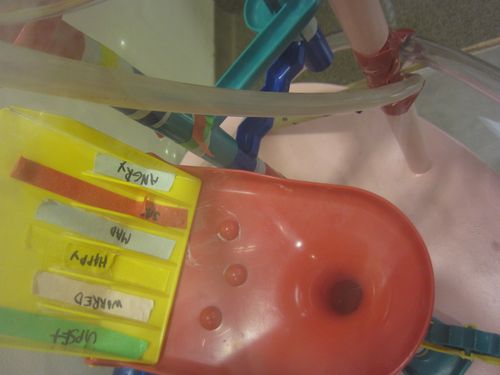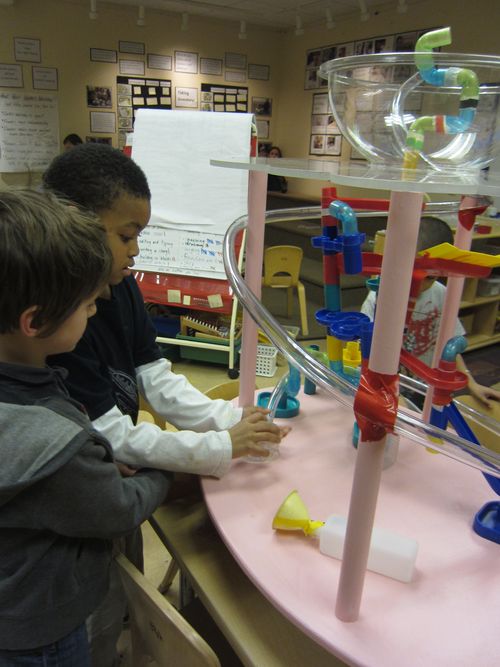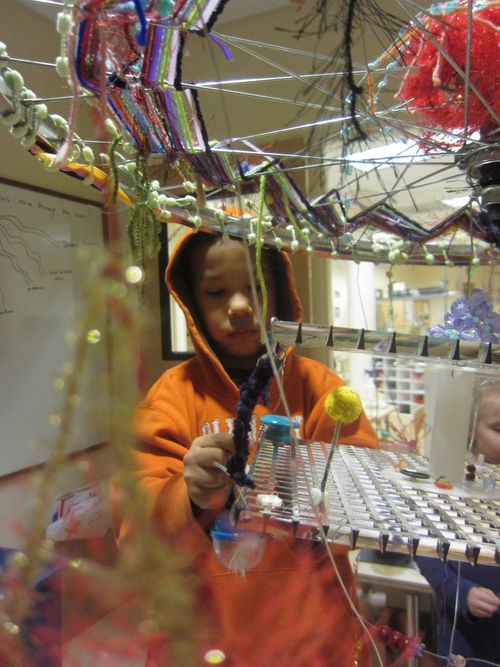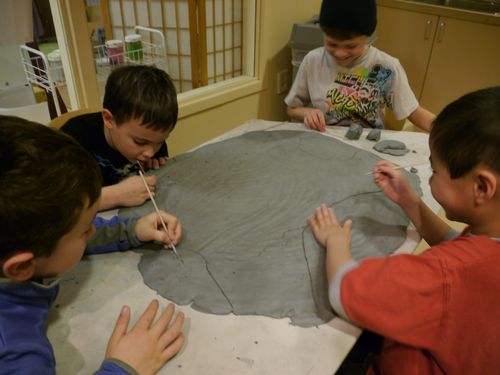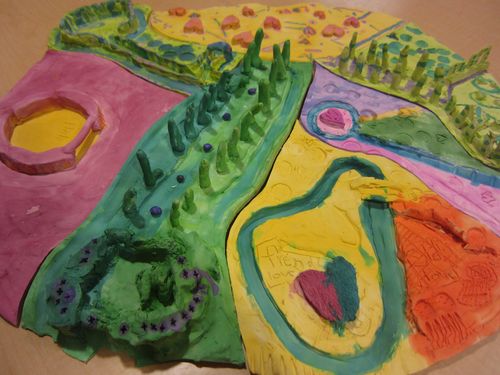Playful Inquiry, Materials and Dialogue
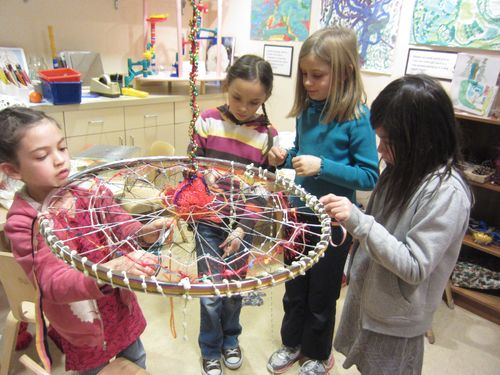
By Carole Burton, Visual Arts Specialist
Last year in Opal 2, the children thought hard about questions about themselves. Using materials, they wondered about the workings of the brain, the heart, and the body. What did we hear in the work they created? What did they hear from the materials? What did they hear from each other?
How do ideas move through the brain?
The children in Opal 2 explored their thinking about this question using the language of drawing. What do their drawings tell us about their thinking, their individual interests and their unique “voice” in the material?
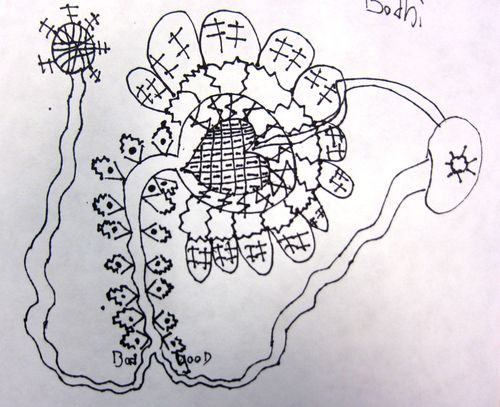
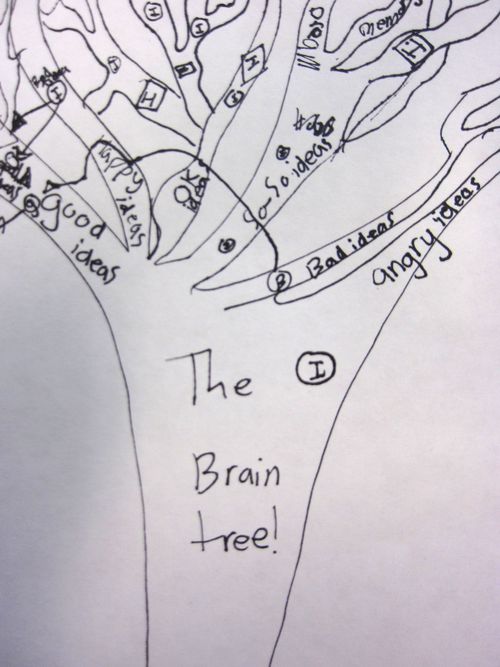
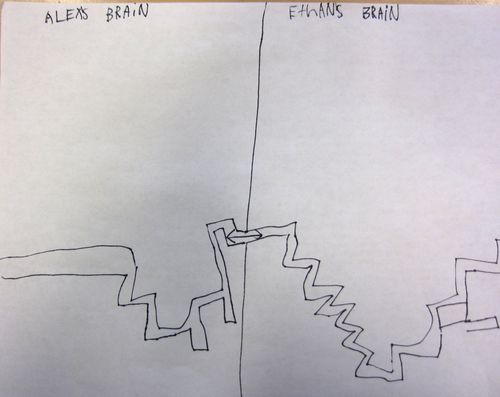
After time spent exploring ideas about the brain in kapla blocks, we noticed that the children had created a metaphor for ideas in the brain using marbles. We invited a group of children to create a model to explain their thinking. In their model, various runs were created to explain different types of ideas—good, bad, memory, science, dreams, emotions. As the children tested the runs on their sculpture, at times the marbles jumped the runs connecting the ideas in their model. In this way, the materials themselves were asking questions of the children, encouraging them to consider different ideas.
Ethan: Sometimes the emotions marbles jump into Alex’s run [good/bad ideas]. Sometimes my emotions turn into bad ideas.
Jawyn : When the science idea [the marble] goes down [through the brain] it starts here and ends up here, the good ideas start here [a different run] and end up here.
Daniel: I think the good ideas and the science ideas should go to the same place, because science ideas can be good ideas.
Alex: The anger run should never work, because it never works to be angry.
What happens when you dream?
A group of children worked to explore dreams in the mind. Working first in collage, then in drawing, they collected their ideas in a collaborative sculpture. With time to explore their thoughts and translate and combine their ideas, their own theories evolved.
This is the middle here where the dreams get made and sometimes it goes through and it picks up a little something thing that it needs. It goes to the bridge and it picks up another thing and it goes to the houses and it picks up another thing. Then when it’s there, that gives it a little thing and this is where the brain is and it comes out and it dreams. MC
The good dreams are really fragile: If they fall, they will break. Max
…and when it visits all the places then you come awake. Because at night, I think, at night your brain turns on whole different. Pearl
This is the bad dream trap. It traps it when they come in. If the trap is not working, you get a bad dream. It’s the same with the good dreams. Sophia and Pritam
Everyone's dreams are different. Each person's brain is connected in a different way. So everyone thinks and dreams differently. Some people have the same memories or feel things – the same things – even if have different brains. Aiofe
When children work collaboratively in a material, they look to find a way to convey their own ideas. They must also listen to the ideas of their partners to understand their ideas well enough to be able to create an artwork that has shared meaning for the group. The dialogue between the children can challenge their understanding of their own ideas as they try to understand each other.
What happens in the heart?
A group of children used clay to explore their idea of “the city of the heart." In their model, the heart has many spaces: emotional love, nature love, friendship love, old love and family love. They included hate, deciding that hate can live in the heart as well. As they worked to make the “tubes,” the roads that connect the spaces, their conversation with each other led them contemplate more questions about the workings of the heart.
Maliya: The roads are so that we can have love that travels like in our picture. We are going through all these tubes.
Daniel: Does hatred travel through it, too?
Bodhi: It does because when hatred moves you get mad.
Daniel: If it went through the same tubes, it would get mad at the love.
Bodhi: It goes through the empty tube that is the hatred tube.
Nissa: There should be spikes.
Teacher: Do the roads leave the heart?
Bodhi: The love and hatred always stay in your heart.
Maliya: And they can go to your brain and your arms since there are tubes that go to those places.
Daniel: And your legs because…
Bodhi: Sometimes, they can go out of your body and that’s when you are out of control.
Maliya: Like when you say something.
Nissa: But that doesn’t always happen.
Daniel: And on your legs too because that’s when you get really mad and you kick and you get really mad at people and you use your body.
Bodhi: This is the heart that keeps the whole heart going.
Nissa: It’s the beat heart.
Bodhi: Yeah it beats everything and it’s really wise.
Nissa: The wise heart.
Maliya: No, it should go to everything then.
Daniel: No, not hatred then.
Bodhi: Yeah, it still does, because it loves everything.
Daniel: It doesn’t love hatred. How could “love” love hate? How could “love” love something that it is the opposite of?
Nissa: Yeah.
Maliya: Because I love my dog and it’s the opposite of me.
Bodhi: Because it wants to make it so that it would be nice, and so…
Daniel: Well, that’s never going to happen—because he’s (hatred) never going to give up.
Bodhi: Well, this guy [wise heart] is never going to give up! He would be nice, he would never give up!
Nissa: Can I just connect it to love?
Bodhi: He will not give up. He will not give up!


